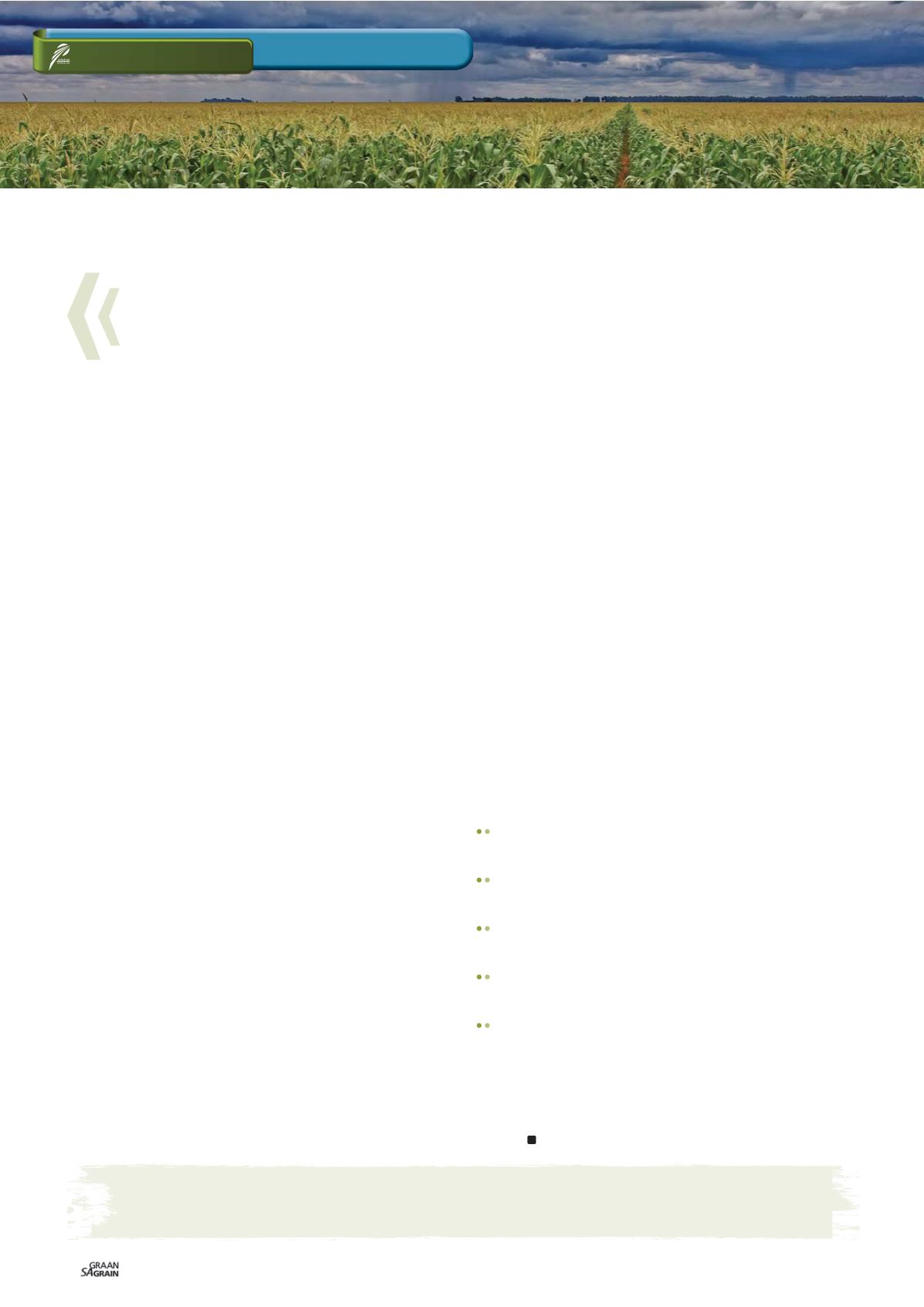

In general, white maize tends to have a higher fat content than
yellow maize, but a lower starch content (except for this season). The
average fat content of the 2015/2016 crop samples was 4,1%, equal
to the previous season and 0,2% higher than the weighted ten-year
average. The fat content of white maize was 0,1% lower than the
previous season, but 0,1% higher than the average of yellow
maize (4%).
The average protein content of 9,7% was the highest since the
1995/1996 season and 0,3% higher than last season. The ten-year
weighted average is 8,8%. The protein content of yellow maize
equalled that of white maize at 9,7%. Yellow maize’s protein content
increased with 0,2% and that of white maize by 0,3%, compared to
the previous season. The ten-year weighted average of white and
yellow maize is 8,8% and 8,9% respectively.
The starch content this season decreased on average by 0,4% com-
pared to the previous season and is 0,3% lower than the ten-year
weighted average of 72,7%. White maize equalled the previous sea-
son’s 72,6%. Yellow maize’s starch content was 0,6% lower than in
2014/2015.
Genetic modification (GM)
The SAGL screened 100 of the crop samples to test for the presence
of the Cry1Ab, Cry2Ab and/or CP4 EPSPS GMO proteins/traits. SAGL
used the EnviroLogix QuickComb kit for bulk grain to quantitatively
determine the presence of genetically modified maize.
94% of the samples tested positive for Cry1Ab (Trade name/Brand
YieldGard®), 78% of the samples tested positive for Cry2Ab (Trade
name/Brand In GenuityTM, VT Triple PROTM and SmartStaxTM) and
99% of the samples tested positive for CP4 EPSPS (Trade name/
Brand Roundup Ready®).
Mycotoxins
None of the 350 samples selected to represent white and yellow
maize from the different production regions, tested positive for Afla-
toxin, Ochratoxin A, HT-2 or T-2 toxin residues.
Fumonisin and Deoxynivalenol were found in samples from all the
maize producing regions, except for Limpopo where no Deoxyniva-
lenol was found the past two seasons. Different patterns of occur-
rence are observed in different seasons. Mean concentration levels
also differ over seasons. Fumonisin tends to show higher mean
concentrations on yellow maize compared to white maize from
the same region. Zearalenone mean concentrations tend to show
better correlation between white and yellow maize from the same
region, than Fumonisin and Deoxynivalenol.
The average Fumonisin level (Sum of B
1
, B
2
and B
3
) on all 350 samp-
les tested, was 325 μg/kg (ppb) and ranged from 0 (not detected
[ND]) to 11 347 μg/kg. This average is higher than the previous sea-
son’s 224 μg/kg. Of the 350 samples tested, 200 samples (57%)
tested positive for Fumonisin levels and the average of these posi-
tive results was 569 μg/kg. The previous season, 56% of the samples
tested positive, with an average of 397 μg/kg.
The highest Deoxynivalenol level detected was 1 585 μg/kg, com-
pared to the 9 736 μg/kg of last season. The average level of all
samples tested this season was 56 μg/kg, with 183 μg/kg the pre-
vious season. 41% of the samples tested positive for Deoxynivale-
nol last season compared to 21% this season. The average of the
positive results decreased from 447 μg/kg in 2014/2015 to 259 μg/kg
in 2015/2016.
2% of the samples tested positive for 15-acetyl-deoxynivalenol
(15-ADON) residues. The average of the positive results was
163 μg/kg compared to 251 μg/kg in the previous season.
Zearalenone residues were found in 5% of the samples and values
ranged from 0 (ND) to 127 μg/kg. The average of the positive sam-
ples was 49 μg/kg compared to the 60 μg/kg of the previous season
when 11% of the samples tested positive.
Mycotoxin levels lower than the limit of quantitation (< LOQ) as
well as limit of detection (< LOD) were seen as having tested nega-
tive for calculation purposes.
National mycotoxin regulations
According to the Foodstuffs, Cosmetics and Disinfectants Act
(Act 54 of 1972) and regulations published under Government Notice
No. R. 1145, dated 8 October 2004, all foodstuffs, ready for human
consumption, may not contain more than 10 μg/kg of aflatoxin, of
which aflatoxin B
1
may not exceed 5 μg/kg.
Amendments to Government Notice No. R. 1145, dated 8 October
2004, published under Government Notice No. 987 of 05 September
2016, specify that:
Cereal grains (wheat, maize and barley) intended for further
processing, may not contain more than 2 000 μg/kg of Deoxyni-
valenol.
Flour, meal, semolina and flakes derived from wheat, maize or
barley, ready for human consumption, may not contain more
than 1 000 μg/kg of Deoxynivalenol.
Raw maize grain, intended for further processing, may not con-
tain more than 4 000 μg/kg of Fumonisins (B
1
+ B
2
), the whole
commodity.
Maize flour and maize meal, ready for human consumption, may
not contain more than 2 000 μg/kg of Fumonisins (B
1
+ B
2
), the
whole commodity.
Further processing means any other treatment or processing
method that has been proven to reduce levels of fungus pro-
duced toxins in foodstuffs intended for human consumption.
The detailed results of local as well as imported maize are availa-
ble on the SAGL website (
www.sagl.co.za ). The annual crop quality
reports in PDF format are also available for download from the
website.
The SAGL is grateful to the Maize Trust for financial support of these annual surveys and to the members
of Agbiz Grain and DAFF inspectors for providing the crop and imported maize samples respectively.
Grain SA/Sasol photo competition
Oktober 2017
106
RELEVANT
Quality overview of maize

















